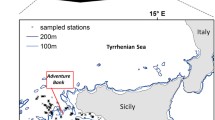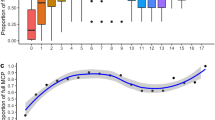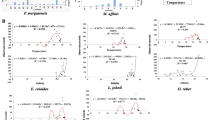Abstract
Invasive species may exhibit higher levels of growth and reproduction when environmental conditions are most suitable, and thus their effects on native fauna may be intensified. Understanding potential impacts of these species, especially in the nascent stages of a biological invasion, requires critical information concerning spatial and temporal distributions of habitat suitability. Using empirically supported environmental variables (e.g., temperature, salinity, dissolved oxygen, rugosity, and benthic substrate), our models predicted habitat suitability for the invasive lionfish (Pterois volitans) in Biscayne Bay, Florida. The use of Geographic Information Systems (GIS) as a platform for the modeling process allowed us to quantify correlations between temporal (seasonal) fluctuations in the above variables and the spatial distribution of five discrete habitat quality classes, whose ranges are supported by statistical deviations from the apparent best conditions described in prior studies. Analysis of the resulting models revealed little fluctuation in spatial extent of the five habitat classes on a monthly basis. Class 5, which represented the area with environmental variables closest to the best conditions for lionfish, occupied approximately one-third of Biscayne Bay, with subsequent habitats declining in area. A key finding from this study was that habitat suitability increased eastward from the coastline, where higher quality habitats were adjacent to the Atlantic Ocean and displayed marine levels of ambient water quality. Corroboration of the models with sightings from the USGS-NAS database appeared to support our findings by nesting 79 % of values within habitat class 5; however, field testing (i.e., lionfish surveys) is necessary to confirm the relationship between habitat classes and lionfish distribution.




Similar content being viewed by others
References
Ahrenholz DW, Morris JA (2010) Larval duration of the lionfish, Pterois volitans along the Bahamian Archipelago. Environ Biol Fish 88:305–309
Albins MA, Hixon MA (2008) Invasive Indo-Pacific lionfish Pterois volitans reduce recruitment of Atlantic coral-reef fishes. Mar Ecol Prog Ser 367:233–238
Alleman RW, Bellmund SA, Black DW, Formati SE, Gove CA, Gulick LA (1995) An update of the surface water improvement and management plan for Biscayne Bay. Technical supporting documents and appendices. In: Mulliken JD, VanArman JA (ed) Planning Department. South Florida Water Management District
Barbour AB, Montgomery ML, Adamson AA, Diaz-Ferguson E, Silliman BR (2010) Mangrove use by the invasive lionfish Pterois volitans. Mar Ecol Prog Ser 401:291–294
Caccia VG, Boyer JN (2005) Spatial patterning of water quality in Biscayne Bay, Florida as a function of land use and water management. Mar Pollut Bull 50:1416–1429
Cerino C (2010) Bioenergetics and trophic impacts of invasive Indo-Pacific lionfish: MSc thesis, East Carolina University
Côté IM, Maljkovic A (2010) Predation rates of Indo-Pacific lionfish on Bahamian coral reefs. Mar Ecol Prog Ser 404:219–225
Côté IM, Green SJ, Morris JA Jr, Akins JL, Steinke D (2013) Diet richness of invasive Indo-Pacific lionfish revealed by DNA barcoding. Mar Ecol Prog Ser 472:249–256
Cressie NA (1990) The origins of kriging. Math Geol 22:239–252
Darling ES, Green SJ, O’Leary JK, Côté IM (2011) Indo-Pacific lionfish are larger and more abundant on invaded reefs: a comparison of Kenyan and Bahamian lionfish populations. Biol Invasions 13(9):2045–2051
Duever MJ, Meeder JF, Meeder LC, McCollom JM (1994) The climate of south Florida and its role in shaping the Everglades ecosystem. In: Davis SM, Ogden JC (eds) Everglades: the ecosystem and its restoration. St. Lucie Press, Delray Beach, pp 225–248
Esri (1994) Environmental Systems Research Institute Ltd. Redlands, CA
Green SJ, Côté IM (2009) Record densities of Indo-Pacific lionfish on Bahamian coral reefs. Coral Reefs 28:107
Green SJ, Akins JL, Côté IM (2011) Foraging behaviour and prey consumption in the Indo-Pacific lionfish on Bahamian coral reefs. Mar Ecol Prog Ser 433:159–167
Green SJ, Akins JL, Maljković A, Côté IM (2012) Invasive lionfish drive Atlantic coral reef fish declines. PLoS One 7(3):e32596
Irlandi EA, Orlando BA, Biber PD (2004) Drift algae–epiphyte–seagrass interactions in a subtropical Thalassia testudinum meadow. Mar Ecol Prog Ser 279:81–91
Jenks GF (1967) The data model concept in statistical mapping. Int Yearb Cartogr 7:186–190
Johnston MW, Purkis SJ (2011) Spatial analysis of the invasion of lionfish in the western Atlantic and Caribbean. Mar Pollut Bull 62(6):1218–1226
Johnston MW, Purkis SJ (2012) Invasionsoft: a web-enabled tool for invasive species colonization predictions. Aquat Invasions 7(3):405–417
Johnston MW, Purkis SJ (2014) Lionfish in the eastern Pacific: a cellular automaton approach to assessing invasion risk. Biol Invasions. doi:10.1007/s10530-014-0696-z
Jud ZR, Layman CA (2012) Site fidelity and movement patterns in the invasive lionfish, Pterois spp. J Exp Mar Biol Ecol 414–415:69–74
Jud ZR, Layman CA, Lee JA, Arrington DA (2011) Recent invasion of a Florida estuarine/riverine system by the lionfish Pterois volitans. Aquat Biol 13:21–26
Jud ZR, Nichols PK, Layman CA (2014) Broad salinity tolerance in the invasive lionfish Pterois spp. may facilitate estuarine colonization. Environ Biol Fish 98:135–143
Kimball M, Miller J, Whitfield P, Hare J (2004) Thermal tolerance and potential distribution of invasive lionfish (Pterois volitans/miles complex) on the east coast of the United States. Mar Ecol Prog Ser 283:269–278
Layman CA, Allgeier JE (2012) Characterizing trophic ecology of generalist consumers: a case study of the invasive lionfish in The Bahamas. Mar Ecol Prog Ser 448:131–141
Lindeman KC, Diaz GA, Serafy JE, Ault JS (1998) A spatial framework for assessing cross-shelf habitat use among newly settled grunts and snappers. Proc Gulf Caribbean Fish Inst 50:385–416
Madley KA, Sargent B, Sargent FJ (2002) Development of a system for classification of habitats in estuarine and marine environments (SCHEME) for Florida. Unpublished report to the US Environmental Protection Agency, Gulf of Mexico Program (Grant Assistance Agreement MX-97408100) Florida Marine Research Institute, Florida Fish and Wildlife Conservation Commission, St. Petersburg, Florida, p 43
Morris JA Jr, Akins JL (2009) Feeding ecology of invasive lionfish (Pterois volitans) in the Bahamian archipelago. Environ Biol Fish 86:389–398
Morris JA Jr, Whitfield PE (2009) Biology, ecology, control and management of the invasive Indo-Pacific lionfish: an updated integrated assessment. NOAA Tech Memo NOS NCCOS 99:57
Roessler M, Beardsley GL, Rehrer R, Garcia J (1975) Effects of thermal effluents on the fishes and benthic invertebrates of Biscayne Bay—Card Sound, Technical Report, Florida. University of Miami, Florida
Rubec PJ, Bexley JCW, Norris H, Coyne MS, Monaco ME, Smith GS, Ault JS (1999) Suitability modeling to delineate habitat essential to sustainable fisheries. In: Benaka LR (ed) Fish habitat: essential fish habitat and restoration, American Fisheries Society, Symposium 22, p 108–133
Rykiel EJ (1996) Testing ecological models: the meaning of validation. Ecol Model 90(3):229–244
Schofield PJ (2009) Geographic extent and chronology of the invasion of non-native lionfish (Pterois volitans [Linnaeus 1758] and P. miles [Bennett 1828]) in the Western North Atlantic and Caribbean Sea. Aquat Invasions 4:473–474
Schofield PJ (2010) Update on geographic spread of invasive lionfishes (Pterois volitans [Linnaeus 1758] and P. miles [Bennett 1828]) in the Western North Atlantic Ocean, Caribbean Sea and Gulf of Mexico. Aquat Invasions 5:S117–S122
Schofield PJ, Huge DH, Rezek TC, Morris Jr JA (2014) Survival and growth of invasive Indo-Pacific lionfish at low salinities. Aquat Invasions (in press)
Serafy JE, Faunce CH, Lorenz JJ (2003) Mangrove shoreline fishes of Biscayne Bay, Florida. Bull Mar Sci 72:161–181
Shul’man GE, Love RM (1999) The biochemical ecology of marine fishes. In: Advances in marine biology, vol 36. Academic Press, San Diego, pp 1–325
Warren RJ II, Bahn V, Kramer TD, Tang Y, Bradford MA (2011) Performance and reproduction of an exotic invader across temperate forest gradients. Ecosphere 2(2):art14
Wedding LM, Friedlander AM, McGranaghan M, Yost RS, Monaco ME (2008) Using bathymetric lidar to define nearshore benthic habitat complexity: implications for management of reef fish assemblages in Hawaii. Remote Sens Environ 112:4159–4165
Whitfield PE, Gardner T, Vives SP, Gilligan MR, Courtenay WR Jr, Ray GC, Hare JA (2002) Biological invasion of the Indo-Pacific lionfish Pterois volitans along the Atlantic coast of North America. Mar Ecol Prog Ser 235:289–297
Whitfield PE, Hare JA, David AW, Harter SL, Muñoz RC, Addison CM (2007) Abundance estimates of the Indo-Pacific lionfish Pterois volitans/miles complex in the Western North Atlantic. Biol Invasions 9:53–64
Acknowledgments
The authors thank Dr. Vanessa McDonough (Biscayne National Park), Judd Patterson (National Park Service), and Omar Abdelrahman (DERM) for generously providing raw data used as model inputs. A special thanks to Dr. Shouraseni Sen Roy (University of Miami) and Chris Hanson (University of Miami) for all of their help in constructing, formatting, and troubleshooting our GIS models. We appreciate comments of Dr. Craig Layman (North Carolina State University) and an anonymous USGS reviewer. This material is based upon work supported by the National Science Foundation Graduate Research Fellowship under Grant No. DG1E-0951782. Don DeAngelis was supported by the USGS’s Greater Everglades Priority Ecosystem Science program. Pam Schofield was supported by the USGS Invasives Program. Any opinion, findings, and conclusions or recommendations expressed in this material are those of the authors(s) and do not necessarily reflect the views of the National Science Foundation. Any use of trade, product, or firm names is for descriptive purposes only and does not imply endorsement by the US Government.
Author information
Authors and Affiliations
Corresponding author
Rights and permissions
About this article
Cite this article
Bernal, N.A., DeAngelis, D.L., Schofield, P.J. et al. Predicting spatial and temporal distribution of Indo-Pacific lionfish (Pterois volitans) in Biscayne Bay through habitat suitability modeling. Biol Invasions 17, 1603–1614 (2015). https://doi.org/10.1007/s10530-014-0819-6
Received:
Accepted:
Published:
Issue Date:
DOI: https://doi.org/10.1007/s10530-014-0819-6




